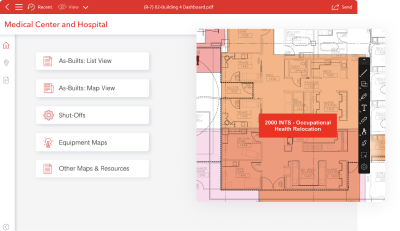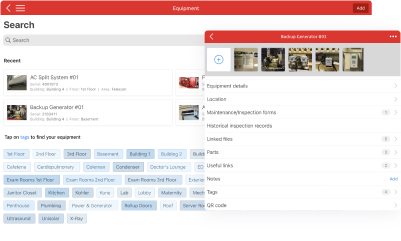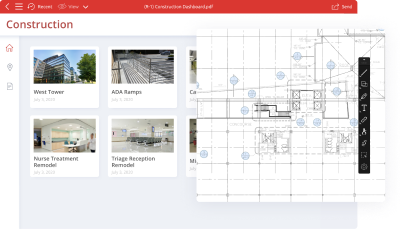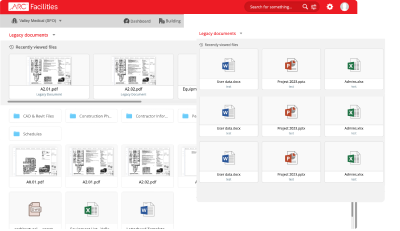With Smart Building Technology Like ARC Facilities as Part of Your Facility Management Software Suite, Your Facilities Team Can Gain Control of All Your Critical Building Information - Allowing Access to Building Information, Which is Typically Stored in a Plan Room or File Servers, from Anywhere in the Field Within Seconds
Empower everyone on your team to access thousands of drawings, O&M documentation or emergency and life safety information all through a simple app whether you are on the field or in a remote location.
Stop spending hours looking for documents and start completing more work orders with the information you need in the palm of your hands.
Your Entire Suite of Facility Management Software Solutions Can be Used More Effectively When You Have Instant Access to Building Information Through a Simple App
Gaining access to as-builts, closeouts, and O&M information is time consuming and has been the biggest bottleneck for the facilities management industry.
A large majority of building owners still maintain physical document storage rooms. Using smart building technology will not only allow you to eliminate messy plan rooms but also file servers which are complex and time consuming in terms of accessing building information. Even better, Smart Building Technology will allow you to create simple links in your CMMS or BMS solutions to access building information such as plans, closeouts, and maintenance records within seconds.
Here's a Real-Life Scenario
Explore Additional Features
ARC Facilities has much to offer to managers and technicians in the field. Explore the useful features of our facility management app to streamline facility management activities. With a few swipes, get building data in real time
Mobile Facility Management Solutions
Access data on the go with our robust facility management app.
Easy to Use Asset Management Software
Map out equipment and asset locations from your mobile device.
As-builts List View and Map View
Access map and list views via an app.
Scan Equipment QR Codes
Maintain, manage, and repair faulty equipment on the go by accessing O&M documentation from QR codes.
Equipment Maps and Shut-off Locations
Avert emergencies and manage breakdowns smoothly with instant access to shut-off locations.
Prevent Loss of Institutional Knowledge
When team members retire or move on. We’ll help you take custody of your building information.
Data Sharing Via Mobile Device
Share building data with team members, emergency responders and others instantly via our facility management app.
Emergency Evacuation Routes
Facility management software helps everyone access Emergency Evacuation Routes during dangerous situations.
Our Powerful Products
Our facility management software is designed to help you quickly respond to emergencies, address equipment maintenance, and prevent institutional knowledge from leaving your facility. With our mobile-friendly app, all parties will be on the same page, whether it's mitigating an emergency or enhancing productivity.

ARC Facilities mobile friendly solutions will let you access building information with just a few taps and a swipe.
LEARN MORE
Don’t wait for minor accidents to become major emergencies. Utilize our game-changing emergency preparedness software to be proactive and mitigate risk.
LEARN MORE
Digitize and gain instant mobile access to healthcare compliance data with our sophisticated and secure healthcare compliance software.
LEARN MORE
Don’t let equipment maintenance slow your facility’s productivity down. Scan the equipment QR details with our highly advanced app and access vendor information on the go.
LEARN MORE
With the Construction Projects module, your critical construction project information is available when and where you need it – accurate, easily accessible and neatly organized.
LEARN MORE
Facilities create many documents such as permit drawings, renderings, sketches, CAD files, contractor information, which aren’t needed every day, but need to be safely stored and retrieved. Using legacy documents, this information is easily accessible, searchable and shareable.
LEARN MORE
Transforming the World of Facilities Management
Our Software is Trusted Across All Industries
ARC Facilities Intuitive Facility Management Software is Helping Organizations Across a Variety of Industries Maintain Business Continuity and Keep Buildings Well-Maintained and Safe.
Healthcare
Hospitals operate 24/7/365 and they’re constantly growing and expanding to accommodate patient’s needs. When facility equipment fails, patient health suffers. Hospitals are subject to annual surveys, so keeping healthcare compliance documentation up to date and in order are ongoing concerns. ARC Facilities provides healthcare facility management teams fast access to building and renovation changes, healthcare compliance documentation and emergency information.
Higher Education
College and university campuses consist of both historic and new buildings. A 100+ year old building may also include a mix of current and newly installed equipment. Public safety, post-pandemic recovery, and student quality of life are important in higher education facilities. Using ARC Facilities on-campus provides technicians with accurate construction documentation, access to emergency info and equipment mapping.
Sports Facilities and Stadiums
Our sports facilities are often packed with large crowds, so concerns about public safety, hygiene and emergency responsiveness are top-of-mind for facility management teams who also must maintain equipment and deliver a quality experience to customers. Stadium facility teams rely on ARC Facilities to map emergency and other equipment and to capture facility knowledge otherwise lost to retirements.
Commercial & Industrial
When disruptions due to floods, fires, and power outages take place at warehouses, manufacturing plants and other commercial and industrial facilities, business continuity and profitability are at stake. Facilities management teams using ARC Facilities have all their building information, equipment maintenance logs and emergency information instantly available to respond to situations that may cause plants to be shut down.
State & Local Government
Typically, state, and local government buildings are 50+ years old, spread out geographically over miles and need ongoing maintenance. These historic buildings, which include prisons, courthouses and recreation facilities are in constant use by the public and government officials. ARC Facilities gives on-the-go facility teams fast access to details including equipment information, historic building plans, and safety information.
Financial Institutions
Banks and credit unions have multiple locations across cities and counties, so facility management requires traveling to and from locations. Facility teams often work short-staffed, so maximizing team efficiency on-the-go is critical. Having building and equipment information at-hand helps technicians in the field be more productive and able to conduct remote troubleshooting when incidents occur after hours or on weekends.
K12 School Districts
With kids, teachers, and staff members learning and working from aging buildings, indoor air quality and active shootings are an ongoing concern, and safety is critical. ARC Facilities gives school facility managers instant access to HVAC locations, evacuation routes and the ability to text inside building information to first responders in the event of an emergency.
Boost Team Productivity with ARC Facilities
Our facilities focused software empowers your team to complete more work orders, improve building safety, and capture legacy knowledge that would otherwise be lost when key individuals retire. Our teams do the work while you stay focused on maintaining safe, efficient facilities.











